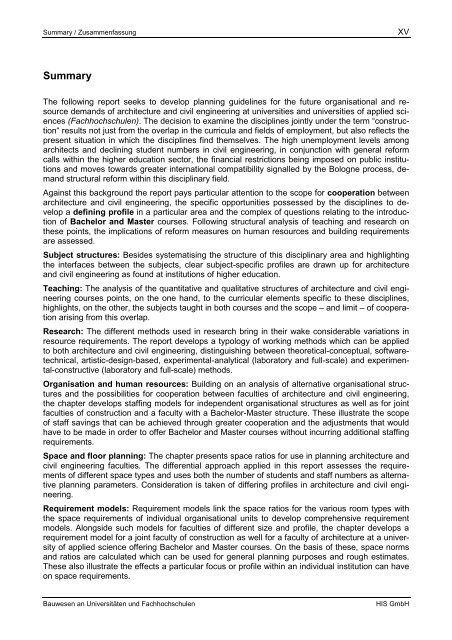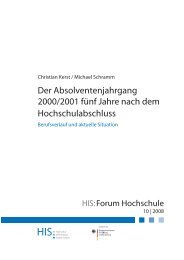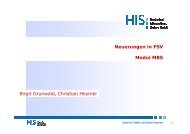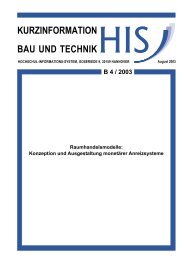Bauwesen an Universitäten und Fachhochschulen
Bauwesen an Universitäten und Fachhochschulen
Bauwesen an Universitäten und Fachhochschulen
Sie wollen auch ein ePaper? Erhöhen Sie die Reichweite Ihrer Titel.
YUMPU macht aus Druck-PDFs automatisch weboptimierte ePaper, die Google liebt.
Summary / Zusammenfassung XV<br />
Summary<br />
The following report seeks to develop pl<strong>an</strong>ning guidelines for the future org<strong>an</strong>isational <strong>an</strong>d resource<br />
dem<strong>an</strong>ds of architecture <strong>an</strong>d civil engineering at universities <strong>an</strong>d universities of applied sciences<br />
(<strong>Fachhochschulen</strong>). The decision to examine the disciplines jointly <strong>und</strong>er the term “construction“<br />
results not just from the overlap in the curricula <strong>an</strong>d fields of employment, but also reflects the<br />
present situation in which the disciplines find themselves. The high unemployment levels among<br />
architects <strong>an</strong>d declining student numbers in civil engineering, in conjunction with general reform<br />
calls within the higher education sector, the fin<strong>an</strong>cial restrictions being imposed on public institutions<br />
<strong>an</strong>d moves towards greater international compatibility signalled by the Bologne process, dem<strong>an</strong>d<br />
structural reform within this disciplinary field.<br />
Against this backgro<strong>und</strong> the report pays particular attention to the scope for cooperation between<br />
architecture <strong>an</strong>d civil engineering, the specific opportunities possessed by the disciplines to develop<br />
a defining profile in a particular area <strong>an</strong>d the complex of questions relating to the introduction<br />
of Bachelor <strong>an</strong>d Master courses. Following structural <strong>an</strong>alysis of teaching <strong>an</strong>d research on<br />
these points, the implications of reform measures on hum<strong>an</strong> resources <strong>an</strong>d building requirements<br />
are assessed.<br />
Subject structures: Besides systematising the structure of this disciplinary area <strong>an</strong>d highlighting<br />
the interfaces between the subjects, clear subject-specific profiles are drawn up for architecture<br />
<strong>an</strong>d civil engineering as fo<strong>und</strong> at institutions of higher education.<br />
Teaching: The <strong>an</strong>alysis of the qu<strong>an</strong>titative <strong>an</strong>d qualitative structures of architecture <strong>an</strong>d civil engineering<br />
courses points, on the one h<strong>an</strong>d, to the curricular elements specific to these disciplines,<br />
highlights, on the other, the subjects taught in both courses <strong>an</strong>d the scope – <strong>an</strong>d limit – of cooperation<br />
arising from this overlap.<br />
Research: The different methods used in research bring in their wake considerable variations in<br />
resource requirements. The report develops a typology of working methods which c<strong>an</strong> be applied<br />
to both architecture <strong>an</strong>d civil engineering, distinguishing between theoretical-conceptual, softwaretechnical,<br />
artistic-design-based, experimental-<strong>an</strong>alytical (laboratory <strong>an</strong>d full-scale) <strong>an</strong>d experimental-constructive<br />
(laboratory <strong>an</strong>d full-scale) methods.<br />
Org<strong>an</strong>isation <strong>an</strong>d hum<strong>an</strong> resources: Building on <strong>an</strong> <strong>an</strong>alysis of alternative org<strong>an</strong>isational structures<br />
<strong>an</strong>d the possibilities for cooperation between faculties of architecture <strong>an</strong>d civil engineering,<br />
the chapter develops staffing models for independent org<strong>an</strong>isational structures as well as for joint<br />
faculties of construction <strong>an</strong>d a faculty with a Bachelor-Master structure. These illustrate the scope<br />
of staff savings that c<strong>an</strong> be achieved through greater cooperation <strong>an</strong>d the adjustments that would<br />
have to be made in order to offer Bachelor <strong>an</strong>d Master courses without incurring additional staffing<br />
requirements.<br />
Space <strong>an</strong>d floor pl<strong>an</strong>ning: The chapter presents space ratios for use in pl<strong>an</strong>ning architecture <strong>an</strong>d<br />
civil engineering faculties. The differential approach applied in this report assesses the requirements<br />
of different space types <strong>an</strong>d uses both the number of students <strong>an</strong>d staff numbers as alternative<br />
pl<strong>an</strong>ning parameters. Consideration is taken of differing profiles in architecture <strong>an</strong>d civil engineering.<br />
Requirement models: Requirement models link the space ratios for the various room types with<br />
the space requirements of individual org<strong>an</strong>isational units to develop comprehensive requirement<br />
models. Alongside such models for faculties of different size <strong>an</strong>d profile, the chapter develops a<br />
requirement model for a joint faculty of construction as well for a faculty of architecture at a university<br />
of applied science offering Bachelor <strong>an</strong>d Master courses. On the basis of these, space norms<br />
<strong>an</strong>d ratios are calculated which c<strong>an</strong> be used for general pl<strong>an</strong>ning purposes <strong>an</strong>d rough estimates.<br />
These also illustrate the effects a particular focus or profile within <strong>an</strong> individual institution c<strong>an</strong> have<br />
on space requirements.<br />
<strong>Bauwesen</strong> <strong>an</strong> <strong>Universitäten</strong> <strong>und</strong> <strong>Fachhochschulen</strong> HIS GmbH

















